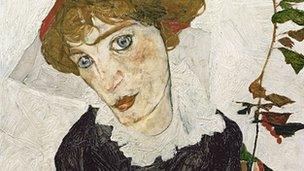Art experts trained to spot work looted during WWII
- Published

In 2010, an Austrian museum agreed to pay a Jewish art dealer's estate $19m for a Schiele painting
Art experts are taking part in a conference in Germany aimed at recovering works looted by the Nazis.
More than 60 years after the end of World War II, there are still millions of lost or stolen items that have yet to be returned to their rightful heirs.
The conference will provide advanced training in cultural plundering.
The Nazis stole an estimated 650,000 religious items and works of art from European Jews during World War II.
"This is an attempt to deal worldwide with the fact that there is no training in this," said Wesley Fisher - director of research for the Conference on Jewish Claims Against Germany.
"There are people who have some expertise... but they have not been formally trained."
<bold>Auction market</bold>
The six-day event in Magdeburg, eastern Germany, has been organised by the European Shoah Legacy and brings together 35 experts from more than a dozen countries.
It marks the first meeting of the new Provenance Research Training Programme, which will later be extended to other countries.
"The press tends to focus on the high end of the art market, the major paintings and so on, but what was taken was far vaster," said Mr Fisher
"Entire libraries were taken - you're talking about millions of books," he added.
Mr Fisher stressed the importance of establishing a network of international experts, as the looted art often travels through several countries.
"Now, over 60 years later, you're beginning to get a situation where people are passing on and the items then end up in the family estate and are being given up for auction, so many of these things have been coming to the art market," he said.
Last year, an online database was launched, with the cooperation of the National Archives and the Commission for Looted Art, which lists missing works.
- Published5 May 2011
- Published21 July 2010
- Published29 July 2010